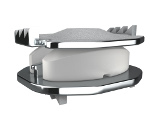 LDR was founded in France in 2000 and came to the United States in 2005. The company's strategy focused on a few areas of novel treatments to build success in the U.S. market. The company has been very successful with the ROI-C, ROI-A and Avenue L products which incorporate VerteBRIDGE Plating Technology, and looks forward to launching the Mobi-C cervical disc in the United States as well. Mobi-C is available in Europe, Asia and Latin America, and has just received conditional approval from the Food and Drug Administration for two-level disc replacement.
LDR was founded in France in 2000 and came to the United States in 2005. The company's strategy focused on a few areas of novel treatments to build success in the U.S. market. The company has been very successful with the ROI-C, ROI-A and Avenue L products which incorporate VerteBRIDGE Plating Technology, and looks forward to launching the Mobi-C cervical disc in the United States as well. Mobi-C is available in Europe, Asia and Latin America, and has just received conditional approval from the Food and Drug Administration for two-level disc replacement. "Outside of the United States, the Mobi-C is our number one product," says Joe Ross, vice president of United States marketing for LDR. "We have great experience in the cervical disc market and we look forward to making it available in the United States."
Mr. Ross discusses the Mobi-C, FDA clearance process and what lies ahead for artificial disc replacements.
Q: Artificial discs are relatively new compared with other spinal procedures in the United States. What was the development process like for the Mobi-C?
Joe Ross: As with procedures in the past, when faced with a diseased segment of the spine, surgeons often fuse them like orthopedists used to fuse hips and knees. Obviously artificial replacements for those joints are the standard of care and over the last 10 to 15 years there have been similar efforts to provide mobile disc replacement for the spine. The hope and desire is to treat the segment and relieve pain while also allowing motion.
We hope that it will lessen or reduce the rate of disease to adjacent segments of the spine, reducing re-operations and other future issues. The Mobi-C cervical disc was developed 10 years ago and we began clinical use outside of the U.S. in 2004. LDR was the first company to run prospective concurrent cervical disc replacement trials for the FDA for both one and two level treatment. We completed enrollment and follow-up, and submitted the data to the FDA in the first quarter of 2011.
Q: The FDA process has been notoriously demanding from device companies to achieve approval, and the regulations are tightening as we speak. How difficult has it been for you to achieve that approvable letter in the cohort submission?
JR: The FDA has conducted a very thorough review of the submitted data and has concluded that there is sufficient evidence to approve the device pending successful completion of remaining audit, inspection and labeling and requirements.
The evaluation process for PMA products like the cervical disc is a long one requiring a multi-year, prospective, randomized trial with a minimum of two-year follow-up. While you always wish that the process could move more quickly, we have been pleased with the progress of the submission and the thorough review by the FDA.
Both our experience at LDR and the recent approvals of other cervical disc devices are a good signal that new technologies can be successfully brought to the market in the United States.
Q: Given today's healthcare environment searching for comparative effectiveness data for quality and cost of new innovations, do you think artificial discs will become more prevalent in the future?
JR: We absolutely feel that the cervical disc replacement is going to become an increasingly popular procedure in the United States just as it has grown in the international markets.
We hope for an increasingly positive response from the payor community for broader coverage in the United States supported by the publication of new evidence from Mobi-C and other discs, as well as long-term data that is now becoming available. ,
Q: How is the Mobi-C differentiated from other cervical discs on the market?
JR: First, from a design standpoint, Mobi-C utilizes well characterized materials and a unique mobile bearing platform. In addition, whereas most other cervical discs use keels or screws for fixation, Mobi-C is designed to minimize stresses between the implant and bone via the mobile core, thereby to eliminating the need for those more invasive fixation mechanisms. Mobi-C was also proactively designed for use in two-level applications.
Mobi-C will be one of the very few devices that will have Level 1 evidence to support its use in two-level procedures which is a significant portion of those patients presenting in the clinic.
Q: What is your strategic plan to maintain success in the future spine market?
JR: We are a company that, since our founding, has focused on technology and opportunities that are truly differentiated from our competition. Cervical disc replacement is becoming a significant global market and LDR is ideally positioned for success.
Of course, differentiated technology is not meaningful unless it translates into a measurable benefit for the surgeon, hospital and most importantly the patient. Those are the opportunities which we will continue to pursue.
More Articles on Spine Devices:
Medical Device Industry: 3 Ongoing Challenges
5 Spine Device Company Financial Reports
24 Spine Devices Receive FDA 510(k) Clearance in October

